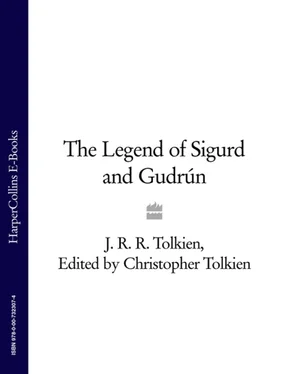J. Tolkien - The Legend of Sigurd and Gudrún
Здесь есть возможность читать онлайн «J. Tolkien - The Legend of Sigurd and Gudrún» — ознакомительный отрывок электронной книги совершенно бесплатно, а после прочтения отрывка купить полную версию. В некоторых случаях можно слушать аудио, скачать через торрент в формате fb2 и присутствует краткое содержание. Жанр: Старинная литература, на английском языке. Описание произведения, (предисловие) а так же отзывы посетителей доступны на портале библиотеки ЛибКат.
- Название:The Legend of Sigurd and Gudrún
- Автор:
- Жанр:
- Год:неизвестен
- ISBN:нет данных
- Рейтинг книги:5 / 5. Голосов: 1
-
Избранное:Добавить в избранное
- Отзывы:
-
Ваша оценка:
- 100
- 1
- 2
- 3
- 4
- 5
The Legend of Sigurd and Gudrún: краткое содержание, описание и аннотация
Предлагаем к чтению аннотацию, описание, краткое содержание или предисловие (зависит от того, что написал сам автор книги «The Legend of Sigurd and Gudrún»). Если вы не нашли необходимую информацию о книге — напишите в комментариях, мы постараемся отыскать её.
The Legend of Sigurd and Gudrún — читать онлайн ознакомительный отрывок
Ниже представлен текст книги, разбитый по страницам. Система сохранения места последней прочитанной страницы, позволяет с удобством читать онлайн бесплатно книгу «The Legend of Sigurd and Gudrún», без необходимости каждый раз заново искать на чём Вы остановились. Поставьте закладку, и сможете в любой момент перейти на страницу, на которой закончили чтение.
Интервал:
Закладка:
My father did not mean to imply that, in history, Attila was the leader in the attack on the Burgundians in 437, for which there is no evidence. He saw that ‘Attila only appears in the story by an early legendary, or dramatic, simplification and heightening of the importance of the battle in which Guðhere perished. He became essential to it.’ In the eighth century the Lombard historian Paul the Deacon (monk of Monte Cassino) knew Attila as the foe; and from his account it is seen that by then the tradition was that Gundahari was not slain in his own town of Worms, but marched eastwards to meet Attila: and this was an invariable feature of the legend in all its forms.
Profound as was the impression made in Germanic legend by the colossal figure of Attila, there is no occasion in this book to outline the history of the most renowned of all the barbarian kings, which necessarily involves the political and military complexities, often obscure, of his relations with the disrupted Empire; and indeed, in the development of the legend in Norse, it could be said that it was the manner of his death that counted for more than his life. At the same time there is no need, I think, to pass over altogether the extraordinarily clear glimpse of that fearful tyrant and destroyer that survives from more than fifteen centuries ago (in such contrast to Gundahari, of whose personal characteristics we know nothing at all).
This is owing to an accomplished and well-informed historian named Priscus of Panium (that being a town of Thrace), whose large work in Greek Of Byzantium and the events connected with Attila survives, lamentably, only in fragments; but one of those fragments contains the story of his journey into Hungary as a member of a small diplomatic deputation to Attila sent out from Constantinople, capital of the Eastern Empire, in the summer of the year 449. Attila received the Roman embassy in the village of wooden buildings that was his headquarters, standing in the midst of a vast plain without stone or tree; and Priscus not only narrowly observed the banquet at which Attila presided, and much else, but described it in such sharp detail as to suggest that he took notes at the time of all that he saw. In this unique account of a barbarian banquet in the Heroic Age Priscus described the elaborate and interminable ceremony in which Attila drank to the health of each guest in turn, and the fine feast served on looted silver dishes with looted drinking-cups of silver and gold – in contrast to the unadorned simplicity of Attila, who drank from a wooden cup and ate only meat, on a wooden plate. He described the entertainment provided: there were singers who chanted songs in praise of the great deeds of Attila; there was a madman, and a buffooning dwarf, who aroused loud laughter, but not from Attila, who sat through all this in grim and rigid silence. But when his youngest son Ernac entered the hall Priscus saw that Attila looked at him ‘with softened gaze’ and stroked his face. He asked a Hun who sat beside him for an explanation of this, and he replied that the soothsayers had told Attila that the fortunes of his family would fail, but would be restored to greatness by this son. The carouse lasted far on into the night, but the Romans prudently withdrew long before it ended.
A description of the physical appearance of Attila is found in the work of a sixth-century historian of the Goths named Jordanes, and this description is directly derived from Priscus, though the original is lost. He was short in stature with a broad chest; his small beady eyes were set in a huge face; his nose was flat and his skin swarthy, his beard straggly and flecked with grey. His step was haughty, and he had a way of darting his glance hither and thither, ‘so that the power of his great spirit appeared in the movement of his body’.
Most important for the large evolution of the legend was the great event of the year 451, the most famous battle of that age. In that year Attila moved with a huge army westwards towards the Rhine, mounting an attack on Gaul for which his motives are obscure. The Huns had destroyed the Ostrogothic power in the east in the fourth century, and Attila ruled over a great mixed dominion, as the Goths had done under Ermanaric (see the commentary on the Lay of Gudrún, stanza 86, pp.322–3). In his empire, and so also in his armies, were many East Germanic peoples; and now in his host came the Ostrogoths under their king Valamer, the Gepids under Ardaric, Rugians, Thuringians, and warriors of other nations beside. Against them came in uneasy alliance the Visigoths (the western Goths) of Tolosa (Toulouse) under their aged king Theodoric, Aetius the Roman general, Burgundians from their new lands in Savoy, Franks, even a contingent of Saxons. The battle is known as the Catalaunian plains (the plain of Champagne) and the Mauriac plain; it was fought in the region of Troyes (a hundred miles south-east of Paris).
Of the course of the battle very little is known. Jordanes, writing a century later, said that it was bellum atrox, multiplex, immane, pertinax (ferocious, confused, monstrous, unrelenting). Theodoric, king of the Visigoths, was among the vast numbers of the slain. The fighting continued into the night, and Attila retreated into his camp, which he had fortified with waggons. According to Jordanes, he had a great funeral pyre heaped up out of horses’ saddles on which he intended to be burnt before final defeat should overtake him.
But the final assault was never made. The alliance against him broke up. Again according to Jordanes, the imminent prospect of the total destruction of the Huns filled Aetius with alarm. His deepest fear was the power of the Visigothic kingdom in the south of France, centred on Toulouse; and despite the eagerness of the young king of the Visigoths, Thurismund, to avenge on the Huns the death of his father in the battle, Aetius advised him to return to Toulouse, lest his brothers should seize the throne in his absence. This counsel Thurismund accepted (‘without perceiving its duplicity’); the Visigoths departed from the battlefield, and Attila was allowed to escape from Gaul.
In the year 452, following the great battle, Attila crossed the Alps, and came down into Italy from the north-east. The cities of the north Italian plain were not only ravaged by the Huns but in some cases actually razed to the ground. Aquileia at the head of the Adriatic, which both as fortress and great trading centre was one of the foremost cities of northern Italy, was so utterly destroyed that when Jordanes wrote, a century later, there was scarcely a trace of it to be seen. Patavium suffered the same fate, and though unlike Aquileia it rose again, it is a striking fact that Padua has no Roman remains.
But Attila never crossed the Apennines, making for Rome. Whatever the reason, he returned to Hungary; and in the following year, 453, he died. The story of his death is known from Jordanes; but Jordanes expressly stated that he was following the authority of Priscus, and it can be taken to be precise history.
Attila in this year added one more to his many wives ( innumerabiles uxores in Jordanes’ words: the Huns were highly polygamous). His wife was a very beautiful girl named Ildico (it has been commonly thought probable that her name shows her to have been of Germanic origin – a diminutive form of Hild , or any name ending in - hild ; perhaps a Burgundian). At the wedding feast Attila became hugely drunk and took to his bed, ‘heavy with wine and sleep’; and there as he lay on his back he suffered a violent nose-bleeding, and was choked to death by the blood passing down his throat. Late on the following day his servants broke down the doors and found him lying dead and covered with blood ‘without a wound’, his bride weeping, covered by her veil.
Читать дальшеИнтервал:
Закладка:
Похожие книги на «The Legend of Sigurd and Gudrún»
Представляем Вашему вниманию похожие книги на «The Legend of Sigurd and Gudrún» списком для выбора. Мы отобрали схожую по названию и смыслу литературу в надежде предоставить читателям больше вариантов отыскать новые, интересные, ещё непрочитанные произведения.
Обсуждение, отзывы о книге «The Legend of Sigurd and Gudrún» и просто собственные мнения читателей. Оставьте ваши комментарии, напишите, что Вы думаете о произведении, его смысле или главных героях. Укажите что конкретно понравилось, а что нет, и почему Вы так считаете.












